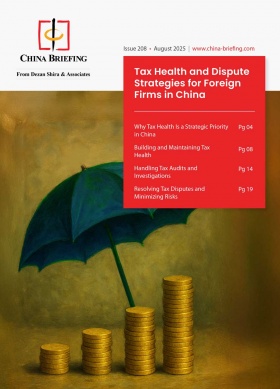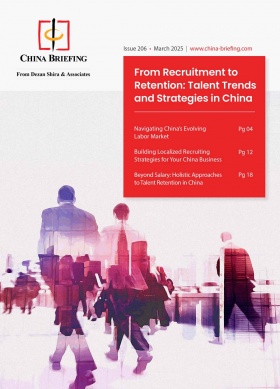China’s Draft VAT Implementation Regulations: A Snapshot for FIEs
China’s Draft VAT Implementation Regulations will reshape tax certainty for foreign-invested enterprises, streamlining compliance, cash flow, and cross-border trade planning.
On August 11, 2025, China’s Ministry of Finance (MOF) and State Taxation Administration (STA) jointly released the Draft Implementation Regulations for the Value-Added Tax Law (“Draft Regulations”) for public comment. This is no minor regulatory tweak — the document is the core administrative companion to the Value-Added Tax (VAT) Law, which takes effect on January 1, 2026.
For foreign-invested enterprises (FIEs) operating in China, the Draft Regulations are particularly important. VAT is China’s largest single tax, contributing roughly 30 percent of total tax revenue, and it touches nearly every sector of the economy. The move from a patchwork of policy circulars toward a more codified, transparent legal framework signals a significant shift toward predictability — something multinational businesses have long sought in China’s tax landscape.
This snapshot outlines the key provisions of the Draft Regulations, highlighting how they enhance tax certainty for FIEs and the practical implications for cross-border trade, investment planning, and daily compliance.
Also read: Unlocking China’s New VAT Law: Key Changes, Business Impacts, and Compliance Tips
Clearer rules on tax scope for cross-border transactions
For FIEs engaged in cross-border services or intellectual property (IP) transactions, one of the most persistent sources of uncertainty has been the definition of “domestic consumption” — the trigger for Chinese VAT liability on imported services and intangibles.
The VAT Law provided only a broad principle: services and intangibles consumed in China are taxable. But “consumption location” has been a grey zone.
The Draft Regulations (Article 4) now specify three circumstances in which services/intangibles are considered consumed domestically:
- Sales to domestic entities where the result is used in China, even if the work is performed remotely abroad. For example, a foreign law firm provides remote advice to a Chinese company, and the legal deliverables are applied in China.
- Direct linkage to domestic goods, real estate, or natural resources. For instance, overseas design services for equipment installed in a Chinese factory.
- Other cases specified by MOF/STA, which is a “policy reserve” clause.
Impact on FIEs:
- Greater certainty in drafting service contracts: The clarified “domestic consumption” tests allow FIEs to build VAT considerations into contract negotiations from the outset. Clearly stating the intended place of use for services and deliverables will now have a stronger legal standing, making it easier to defend VAT positions against challenge. This is especially valuable for sectors such as professional services, R&D, and IP licensing, where the location of use has historically been contested.
- Reduced risk of retroactive tax assessments: Inconsistent interpretations between provinces, and even between local tax bureaus, have often led to surprise assessments years after transactions occurred. By narrowing interpretive room, the Draft Regulations reduce the risk of backdated VAT liabilities, penalties, and interest — enabling more reliable financial reporting.
- Better alignment with OECD VAT/GST principles: The new framework mirrors global norms by focusing on the location where services and intangibles are effectively consumed. This facilitates coordination with group VAT/GST policies across jurisdictions, supports more efficient intercompany charging structures, and reduces the need for complex, jurisdiction-specific compliance workarounds.
Optimized input VAT deduction for long-term assets
Capital-intensive FIEs — in manufacturing, logistics, infrastructure — often face VAT cash flow challenges when acquiring major assets like plants or production lines. Under current rules, “mixed-use” assets (serving both taxable and exempt activities) have deduction rules that are vague and hard to plan around.
The Draft Regulations (Article 26) introduce a two-tier, phased deduction model:
- Assets ≤ RMB 5 million: Full input VAT deduction upon purchase.
- Assets > RMB 5 million: Full deduction upfront, followed by annual downward adjustments during the asset’s depreciation or amortization period to reflect any use for exempt or simplified-tax projects.
Example:
An FIE buys a production line worth RMB 10 million (VAT rate: 13%), with 30% of output allocated to VAT-exempt goods.
- Deduction at purchase: Full RMB 1.3 million input VAT (RMB 10 million × 13%).
- Annual adjustment: (RMB 10 million × 13% ÷ 10 years) × 30% = RMB 39,000 per year.
Impact for FIEs:
- Improved cash flow for large capital projects: The ability to deduct full input VAT upfront, even for high-value assets, reduces the strain on working capital during investment phases. This is a marked improvement for FIEs in sectors with heavy upfront capital expenditure and long payback cycles, such as advanced manufacturing, renewable energy, and transportation.
- More predictable tax planning: The phased adjustment model introduces a transparent, formula-based approach for allocating input VAT on mixed-use assets over their useful life. This allows CFOs and tax managers to build more accurate multi-year tax forecasts, which is particularly valuable for multinational headquarters evaluating China-based expansions.
- Reduced compliance disputes: In the past, apportionment rules were vague, leading to disagreements over when and how to adjust deductions. The new provisions standardize the approach, making it easier for FIEs to maintain compliance and defend their treatment in the event of a tax audit.
Defining the zero-rating scope for cross-border services
Zero-rating — applying a 0 percent VAT rate with input tax refunds — is a major competitiveness factor for China-based exporters of services and intangibles.
Previously, the exact list of eligible activities was scattered and sometimes ambiguous. The Draft Regulations (Article 9) provide a structured list, including:
- R&D, design, software, and similar technical services that are fully consumed abroad.
- Transfers of technology that are fully consumed abroad.
- International transport, aerospace launch services, and certain outward processing activities.
Impact on FIEs:
- Streamlined eligibility assessments: The consolidation of eligible zero-rated service categories into a single regulation eliminates the need to sift through scattered circulars. FIEs can now quickly confirm whether a given transaction qualifies for zero-rating, accelerating contract approvals and internal decision-making.
- Enhanced competitiveness for service exports: Clearer zero-rating rules make China a more attractive base for exporting knowledge-intensive services, such as software development, R&D, and high-end design, by ensuring these activities can benefit from 0 percent VAT with input tax refunds.
- Lower refund rejection risk: When refund eligibility was governed by loosely worded notices, local tax offices sometimes denied claims on narrow interpretations. The Draft Regulations’ explicit definitions reduce this risk, improving cash flow predictability and enhancing trust in China’s VAT refund system.
More transparent and standardized tax incentive rules
VAT exemptions exist for certain socially beneficial sectors (such as agriculture, healthcare, education, and elderly care), but until now, operational details were buried in lower-level rules subject to frequent change.
The Draft Regulations (Articles 27–33) spell out specific eligibility criteria, such as:
- “Medical institutions” must hold formal licenses; cosmetic medical providers are excluded.
- “Educational institutions” eligible for exemptions must award nationally recognized qualifications.
- “Elderly care institutions” must provide registered, centralized accommodation and care.
They also mandate public disclosure of incentive criteria and explicitly prohibit claiming benefits without separate accounting or by submitting false documents.
Impact on FIEs:
- Greater certainty in investment feasibility studies: With exemption criteria now enshrined in a formal regulation, FIEs can factor VAT benefits into financial models with higher confidence, enabling more accurate ROI analysis for projects in healthcare, education, agriculture, and elderly care.
- Reduced policy volatility: Codifying exemption rules at a higher legal level makes them more stable and less vulnerable to abrupt changes via low-level circulars. This stability is especially important for FIEs making long-term sectoral commitments.
- Heightened compliance obligations: The explicit prohibition on false claims and the requirement for separate accounting heighten the need for robust documentation and internal audit processes. Non-compliance risks extend beyond financial penalties to include reputational damage, which can be particularly sensitive for foreign brands in China.
Enhanced operational guidance for VAT administration
The Draft Regulations also refine rules that directly affect FIEs’ tax management, including:
- Consolidated filing: HQ–branch VAT consolidation now requires MOF/STA approval for cross-province setups, and provincial approval within a province.
- Prepayment for certain projects: Clearer prepayment rules for cross-regional construction, real estate pre-sales, and oil/gas sales.
- Invoice management: Prohibition on issuing special VAT invoices to individuals or for VAT-exempt transactions; stricter rules for issuing “red” correction invoices.
Impact on FIEs:
- Fewer operational surprises during audits: Clearer rules on invoice issuance, such as the ban on issuing special VAT invoices for exempt transactions or to individuals, reduce the risk of accidental non-compliance. This is particularly helpful for large FIEs with decentralized invoicing functions.
- More strategic corporate structuring: With the consolidation filing rules now more explicit, FIEs can better evaluate the tax and administrative pros and cons of centralizing VAT filings across branches, especially for operations spanning multiple provinces.
- Improved cash flow management: Predictable rules on VAT prepayments for cross-regional construction, real estate pre-sales, and specialized service projects enable more accurate cash flow forecasting. This allows treasury teams to plan for VAT obligations as part of overall working capital management rather than as unexpected outflows.
Preparing for the new VAT era
The Draft Regulations do more than fill in legal blanks — they aim to create a coherent, internationally aligned, and operationally workable VAT framework. For FIEs, this offers both a chance to reduce compliance friction and a responsibility to adapt internal systems before the January 1, 2026, effective date.
But certainty also comes with complexity. Businesses that invest early in understanding the new rules, aligning contracts and processes, and engaging in the consultation process will be best positioned to thrive in China’s evolving tax landscape.
We would like to offer below practical steps for FIEs now:
- Review cross-border contracts to ensure service location-of-use clauses match the new “domestic consumption” definitions.
- Reassess capital investment plans, modelling VAT impacts under the phased deduction approach.
- Map export service offerings against the clarified zero-rating list and adjust business models accordingly.
- Audit VAT incentive claims to ensure future eligibility under the formalised criteria.
- Update internal VAT controls for invoice issuance, prepayment obligations, and consolidation approvals.
About Us
China Briefing is one of five regional Asia Briefing publications, supported by Dezan Shira & Associates. For a complimentary subscription to China Briefing’s content products, please click here.
Dezan Shira & Associates assists foreign investors into China and has done so since 1992 through offices in Beijing, Tianjin, Dalian, Qingdao, Shanghai, Hangzhou, Ningbo, Suzhou, Guangzhou, Haikou, Zhongshan, Shenzhen, and Hong Kong. We also have offices in Vietnam, Indonesia, Singapore, United States, Germany, Italy, India, and Dubai (UAE) and partner firms assisting foreign investors in The Philippines, Malaysia, Thailand, Bangladesh, and Australia. For assistance in China, please contact the firm at china@dezshira.com or visit our website at www.dezshira.com.
- Previous Article What Will China’s Economic Policy Look Like in H2 2025?
- Next Article








